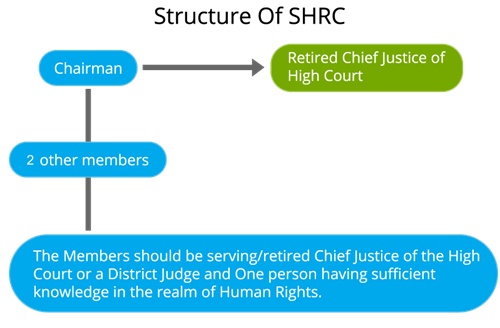PDF chapter test TRY NOW
The National Human Rights Commission (NHRC)
The National Human Rights Commission is a “Statutory body” (One created by law). It came into existence after the enactment of the “Protection of Human Rights act” on \text{October 12, 1993}.
The NHRC of India is considered the apex institution that takes action against the breach of Human Rights in the country and earned the sobriquet “Watchdog of Human Rights” in India.
Objectives of the Commission:
1. To hear the allegation of excesses and enquire the complaints on Human rights violations.
Strengthening the institutional framework of human rights in the country.
2. To complement the efforts of institutions that had taken steps in the direction of human rights.
Structure of the Institution:

Delhi: The office of the National Human Rights Commission is located in the capital city of Delhi. The Chairman and members of the NHRC are appointed by the President.
The Commission is empowered to take “Suo-Moto” actions (Actions on its own) without receiving a formal complaint/allegation.
Functions of the NHRC:
1. To inquire into any negligence and violation of human rights in the prevention of such violations by a public servant.
2. To visit the detention places and study the living conditions of the inmates and recommend for the betterment of their condition.
3. To intervene in any proceedings of the court regarding human rights violation.

National Human Rights
4. To study international treaties and other documents on human rights and incorporate those in their recommendations.
5. To Promote and proliferate the principles of human rights among the masses.
Encouraging the activities of Non-Governmental organisations in the field of human rights.
The State Human Rights Commission (SHRC):
The Provisions of the “Protection of Human rights act 1993” enables for the establishment of the Human rights commission in a State under Section 21.
Currently, the Institution of SHRC has seen in 26 States of India. The Commission inquires about the violation of subjects in the State List and the Concurrent List.
The Members and the Chairperson of the Commission are appointed by the Governor of the State but are removed only by the President.
Structure of the Commission:

Functions of the Commission:
1. To Inquire into any negligence and violation of human rights in the prevention of such violations in matters present in Concurrent and the State list.
Concurrent list: The list contains subjects/ items in which both the Central and the state governments have equal powers to legislate.
2. Most of the functions of the Commission are very similar to the National commission but are highly confined to the state list.
3. It can recommend the state government or an authority to pay compensation for the damages of the victim.
4. The Commission has the powers of the Civil Court, and its proceedings have a judicial character.
